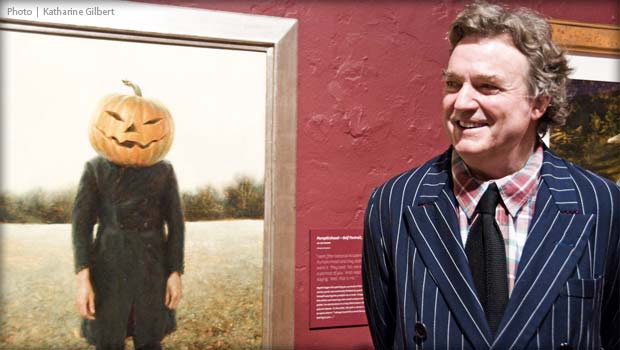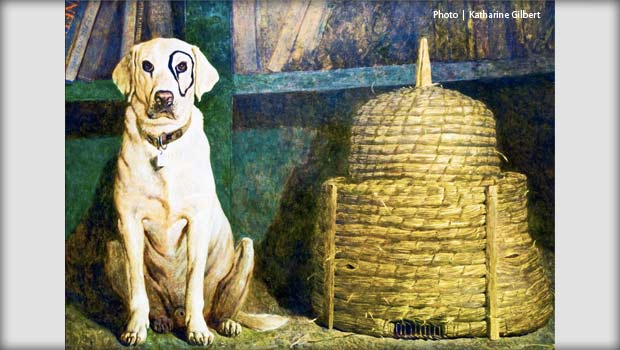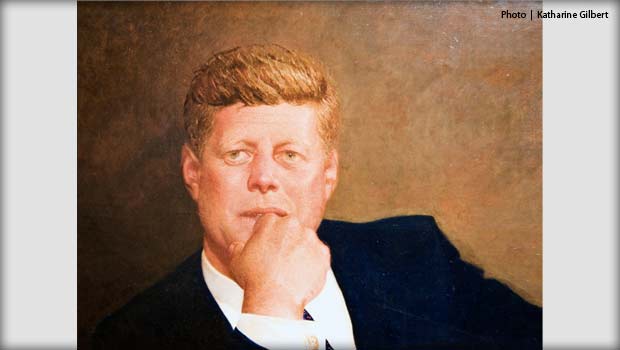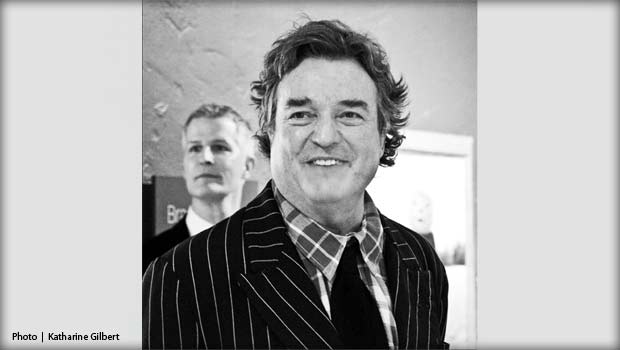By Sabina Clarke
Jamie Wyeth…A Retrospective opened at Brandywine Museum on January 19th and continues through April 5th, 2015. Prior to its Chadds Ford run the exhibit debuted at the Boston Museum of Fine Arts where it shattered all attendance records for the Torf Gallery and was seen by 181,489 visitors. Of all the Wyeth’s, Jamie is the most versatile, working in many mediums on a vast canvas. There is the influence of his father Andrew Wyeth in his seascapes, coastal Maine and Brandywine Valley and also the imagination and wild abandon of his grandfather, N.C. Wyeth, the legendary and prolific illustrator of classic tales such as King Arthur and Robinson Crusoe.
Now the trajectory of his amazing career—a third generation maverick in a celebrated American dynasty — is brilliantly on display at the Brandywine River Museum and it is a show you don’t want to miss.
Jamie Wyeth committed himself to his art at age 11 convincing his parents to allow him to be tutored at home and study art in the afternoons with his eccentric aunt Carolyn. “She made me draw spheres and cubes for the first year which I found boring but I learned to love oil from watching her squeeze it out of tubes; it looked so edible. Carolyn was amazing — she had a complicated relationship with her father (famed illustrator N.C. Wyeth). They hated one another and after he was dead she ended up dressing in his clothes.”
Wyeth calls painting “difficult” and describes himself as “boring” and simply one who records. His humility is real — a trait not often encountered in one so gifted — that it seems almost like an aberration.
A giant poster of Kleberg his beloved Yellow Labrador Retriever with a permanent black circle painted around his eye welcomes visitors to the exhibit. The actual painting Kleberg, oil on canvas, is included in the exhibition and was painted by Wyeth in 1984. “I was inspired by the dog in the Our Gang comedy and decided to try painting a circle around Kleberg. He liked it and wore that circle for the rest of his life. People would say how amazing his markings were.”
DEN-DEN
Also in the exhibition is his pet pig Den-Den who was rescued by Wyeth from the butcher’s block and became his model for Portrait of Pig, oil on canvas, painted in 1996, “Den-Den originally belonged to a farmer who I helped when his cattle broke out. Later, when I was painting in the barn I heard this snorting, it was Den-Den; she had eaten 22 tubes of my paint. She had all these rainbow droppings and the farmer decided to take her to the butcher and I said, ‘No, I can’t have that. I’ll take her.’ By consuming and surviving 22 tubes of my paint she had endeared herself to me. So I took her to our farm at Point Lookout where she lived a long and happy life.”
MUSEUMS FULL OF DEAD PAINTERS
It is hard to imagine that Jamie Wyeth with his prodigious talent finds the experience of his first major retrospective a bit uncomfortable — but it is obviously true, “I’m not being cute but I do find it sort of uncomfortable. It is like sitting in a room and everyone is reading everything you’ve written at the same time — you kind of feel like a jackass. Also, I kind of feel like I’m dead or something — you know I’m still working my head off. Young people tell me that museums are full of a lot of dead painters. So, that’s why I hope young people come to this because I’m still walking around.”
WYETH’S EARLIEST DRAWINGS
The retrospective includes Jamie Wyeth’s earliest childhood drawings and more than 100 paintings some depicting the landscapes of Brandywine Valley and coastal Maine, family members and fellow artists, domesticated and wild animals and two mixed media assemblages that the artist calls “tableaux vivants,” miniature replicas of the Factory Dining Room with Andy Warhol and friends and La Cote Basque, a chic New York restaurant frequented by writer Truman Capote and his friend Joanna Carson and ballet impresario Lincoln Kerstin and ballet dancer Rudolf Nureyev — a nostalgic nod to Wyeth’s time spent in New York in the 1960’s and mid-1970s .
RECURRING DREAM
Organized thematically, the exhibition showcases the people and places most familiar to Wyeth and a diverse sampling of animals and seascapes conjured in dreams such as Sea Watchers, and The Sea Watched, both oil on canvas painted in 2009 and A Recurring Dream, acrylic, oil and watercolor painted in 2011. All of these paintings were inspired by a recurring dream, “It was shortly after my father’s death. I don’t dream that much but I had a recurring dream about this scene on Monhegan Island to the point that I thought it actually happened. So I thought the only way to work through this, is to see if I can paint it — which I did. There are about seven or eight versions of it which is a little peculiar and one of them is owned by Stephen King which shows you how peculiar it is. And in the evolution of it, more and more figures are eliminated with one of them A Recurring Dream showing just my father and grandfather on the shore watching the sea.”
There are sentimental and captivating portraits of his wife Phyllis in pursuit of her passion for carriageing that are powerfully portrayed in And Then into the Deep Gorge, oil on canvas painted in 1975 and Connemara Four, oil on panel painted in 1991. The magnificent white horses in Connemara Four are astounding while the luxuriant green hues and mood of And Then Into the Deep Gorge are vibrant and mysterious.
When Jamie Wyeth was just 20 years old, the ballet impresario Lincoln Kerstin anointed him “the best portrait painter in America since the death of John Singer Sargeant.” And this statement now seems prescient.
At the age of 17, Wyeth painted Portrait of Shorty, depicting a local Chadds Ford character — achieving the effect of someone far beyond his years with echoes of Flemish realism. At the age of 20, he was commissioned by Jacqueline Kennedy to paint a posthumous portrait of JFK. When it was completed in 1967, the painting was controversial — but has since become one of the best known and best loved portraits of the former president. “Initially it was Bobby Kennedy who objected to it saying, ‘Do we really want to perpetuate that side of Jack?’ He thought it looked like Jack during the Bay of Pigs crisis. But his widow said she saw that look a lot in Jack and was astounded that I got that look.”
Other portraits in the exhibition include Wyeth’s New York mentor Lincoln Kerstein, ballet star Rudolf Nureyev, pop artist Andy Warhol, his father Andrew Wyeth, his wife Phyllis, and some locals from Maine and Chadds Ford.
SC How did you capture that expression of JFK and was it difficult to imagine since you had never met him?
JW Yes, it was, particularly since I had never met him. So I tried to establish the memory by looking at hours of film and photographs of him. It was hugely controversial at the time of the show and now it is on the national stamp of Ireland.
PORTRAIT OF DR. TAUSSIG
Jamie Wyeth’s ability to plumb beneath the surface and capture the essence of his subjects has occasionally evoked controversy such as when at age 17, he received his first commission to paint the portrait of pioneering pediatric cardiologist Dr. Helen Taussig, oil on canvas, painted in 1963 — that is also included in the exhibit. What is most striking about Dr. Taussig’s portrait is her no nonsense attitude and her steely blue eyes. When the portrait of Dr. Taussig was unveiled at her retirement party her friends and colleagues gasped. They were horrified; the painting was not what they expected.
SC How does negative criticism affect you?
JW Well you can almost expect that. With the portrait of Dr. Taussig they wanted to destroy it on two occasions. The painting’s confrontational pose was not what they expected. They wanted her to look like Betty Crocker — looking sweet and unimportant. And I did this amazing woman with intense blue eyes that would drill right through you. That is exactly what I saw and they didn’t want it — they were horrified. The whole controversy was about women and medicine. Now the Head of John Hopkins has it hanging in her office and she said she looks at it for inspiration every day. And just recently when I had the opening in Boston, a delegation from John Hopkins came to apologize. I told them that from the age of 17, I have been carrying those scars.
Wyeth’s many drawings and portraits of dancer Rudolf Nureyev combine art and anatomy. He studied the dancer’s body and physical characteristics for more than 18 months both onstage and offstage.
SC What was Nureyev like?
JW He was the closest person to an animal that I ever worked with and also one of the most difficult. He told me that he was more concerned about how he was going to look in paintings and drawings than anybody I’ve ever worked with. He is a dancer, so his life is his visage — how he appears. He was very controlling. I was very intrigued with him. He would come and stay with us and it seemed like there was a panther in the house. I didn’t know if he was male, female, dog or cat—it was absolutely amazing! He was always on stage because he was king. Then after his death, I did these series of paintings that I think are more interesting. I had drawn him so much that I could practically draw him in my sleep.
Deceased pop artist Andy Warhol appears in several drawings and in Portrait of Andy Warhol, oil on panel painted in 1976. He appears stoic, sallow and statue-like — as if frozen in time — while seated holding his pet dachshund.
SC What was Warhol like?
JW He was a great deal of fun, very child-like, a fascinating person. If he was around people he didn’t know, he wouldn’t say a word — absolute silence. We had a great time. We spent most of our time going to toy stores. He came to Chadds Ford a lot. He said he liked it here because the TV reception was better. He’d just sit and watch TV.
Dominating one room is Warhol’s captivating classic silkscreen in pink, blue and black of a handsome young Jamie Wyeth that is suggestive of a matinee idol. And an arresting Portrait of Lincoln Kerstein, oil on canvas, of the ballet impresario painted in 1965. What is most striking about that portrait is the unusual pose of Kerstein with his back to the viewer and his hooked nose prominently profiled.
SC Why did you paint him in this pose?
JW He was very tall and he dressed only in black with a white shirt and a black tie. He didn’t like people very much and would usually walk away from you. He always had his back to people.




